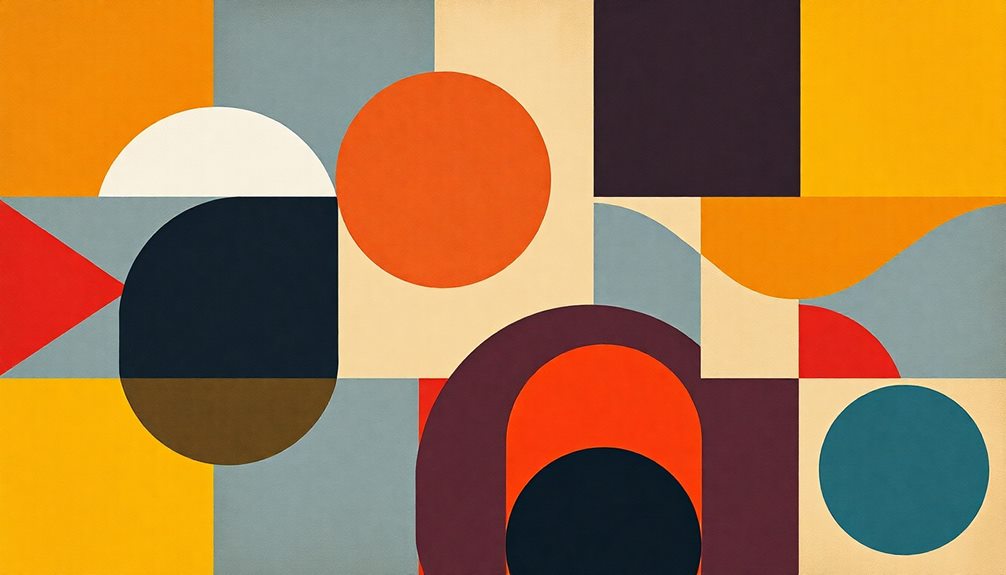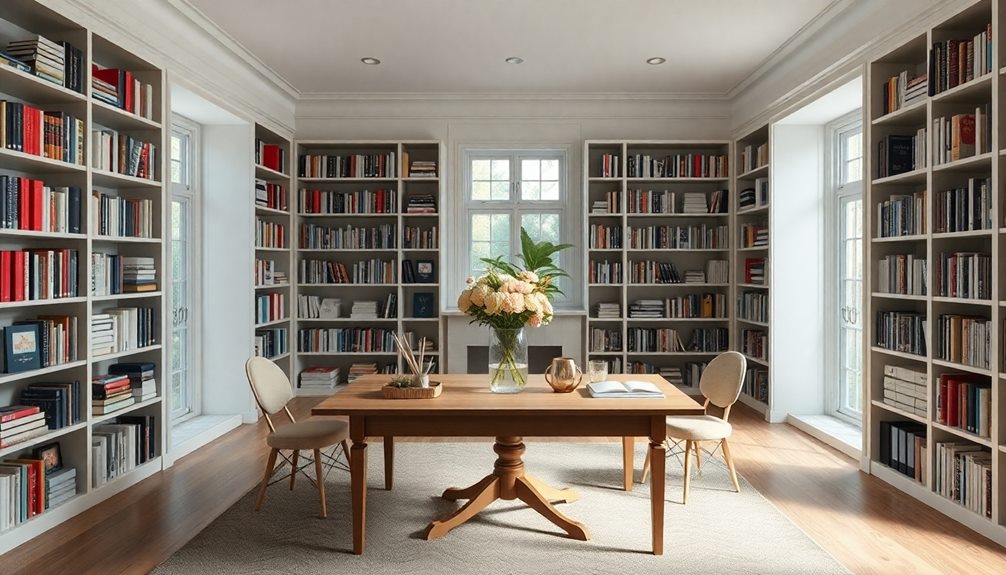Visual balance is vital for how you perceive art, influencing your emotions and overall enjoyment. It can be symmetrical, where elements mirror each other, or asymmetrical, creating tension with contrasting features. As you analyze artwork from a formalist perspective, you'll notice how balance directs your attention and enhances aesthetic appeal. Techniques like contrast, size, and placement deepen your connection. Artists like Mondrian and Kandinsky expertly illustrate these principles, showcasing the role of balance in their work. Explore further to uncover how understanding these concepts can enrich your appreciation of various art movements.
Key Takeaways
- Visual balance, encompassing symmetrical and asymmetrical arrangements, is essential for conveying emotion and meaning in art.
- The distribution of visual weight in a composition influences the viewer's emotional connection and aesthetic appreciation.
- Contrast and movement in visual elements guide attention and create dynamic compositions, enhancing overall harmony.
- Personal experiences and cultural backgrounds shape individual perceptions of visual balance in art, leading to diverse interpretations.
- Formalism emphasizes the importance of form and structure, focusing on visual elements like line, shape, and color for art analysis.
Introduction

Visual balance serves as a foundation for understanding how art communicates emotion and meaning. When you look at a piece of artwork, you instinctively sense its visual weight—the way elements are arranged creates harmony or tension. This balance can be symmetrical, with elements evenly distributed around a central axis, or asymmetrical, where contrasting elements achieve equilibrium in a more dynamic way. Just as in art, the careful arrangement of elements is crucial in creating an immersive experience in other fields, such as the role of color accuracy in home cinema projectors.
As you analyze art through a Formalist lens, you'll notice how visual balance guides your eye, directing your attention to focal points and enhancing the work's overall impact. Artists skillfully manipulate these principles to evoke feelings and convey messages, making balance crucial for aesthetic appeal.
Understanding visual balance not only enriches your appreciation of art but also opens doors to various movements like Cubism and Abstract Expressionism. These styles often challenge traditional notions of form and balance, presenting unconventional arrangements that invite deeper engagement.
Key Concepts and Definitions

Understanding key concepts and definitions around visual balance helps you appreciate its role in art more deeply.
Visual balance refers to the distribution of visual weight within a composition, creating stability and harmony among its formal elements. There are two primary types of balance: symmetrical and asymmetrical. In symmetrical balance, elements mirror each other on either side of a central axis, while asymmetrical balance arranges different elements to achieve equilibrium without mirroring.
This understanding of balance is essential to artistic practice and can influence the viewer's emotional connection to the work.
The principle of balance is crucial in artistic expression, as it affects how viewers perceive and emotionally respond to a piece. Achieving visual balance often involves using contrasting elements—like light and dark colors or large and small shapes—to draw attention and spark interest.
This interplay can guide your eye throughout the artwork, ensuring that no single part overwhelms the overall composition.
Visual Composition Techniques

In art, composition techniques play a vital role in achieving visual balance and harmony. You can use various visual composition techniques to arrange elements like line, shape, and color, allowing them to interact and enhance the overall aesthetic of your artwork.
Balance in composition is crucial, which can be achieved through symmetrical balance, where elements are evenly distributed around a central axis, or asymmetrical balance, which relies on contrasting elements placed unevenly to create visual equilibrium. By embracing a mindset that encourages exploration and experimentation, artists can enhance their creative process, paralleling concepts found in the importance of nurturing an imaginative mindset.
Contrast is another powerful tool to draw attention to key areas within your composition. By juxtaposing differing elements, such as light against dark or large shapes against small ones, you guide the viewer's eye and create a dynamic flow.
Movement is also essential; strategically placing lines and colors can direct the viewer's gaze, adding dynamism to your piece.
Notable Artworks Illustrating Balance

Artworks throughout history have brilliantly illustrated the concept of balance, each offering unique insights into how elements can coexist harmoniously.
Piet Mondrian's "Composition with Yellow Lines" exemplifies visual balance through its meticulous arrangement of geometric shapes and color, reflecting his formalist principles. The clean lines and primary colors create a sense of order and stability.
Wassily Kandinsky's "Composition VII" showcases balance by integrating a dynamic interplay of colors and forms. Here, you can see how the energetic interactions foster both visual equilibrium and emotional depth, making it a compelling piece.
Henri Matisse's "The Dance" captures balance through the rhythmic placement of figures. The bold colors unify the composition and guide your eye across the canvas, creating a dance of visual harmony.
Georges Braque's "Violin and Candlestick" employs fragmented forms and muted colors to achieve balance, inviting you to explore the relationships between the objects depicted.
In "Water Lilies," Claude Monet achieves balance through color harmony and repetitive patterns, crafting a tranquil space that captivates while adhering to formalist aesthetics.
Each artwork uniquely exemplifies how visual balance can bring depth and meaning to artistic expression.
Tips and Best Practices

To achieve visual balance in your compositions, you'll want to spread out visual weight evenly across the artwork so that no single element overwhelms the space.
Start by choosing between symmetry and asymmetry. Symmetrical compositions often convey stability, while asymmetrical arrangements can create dynamic tension and intrigue.
Next, consider the size, color, and texture of your elements. Larger, brighter, or more textured components draw more attention and may require careful placement to maintain balance.
For instance, if you have a vibrant object on one side, you might want to add a less intense counterpart on the opposite side.
Implement the principle of contrast effectively to lead the viewer's eye. Contrasting elements can create focal points that enhance the overall balance of your piece.
Audience Interpretation Varies Widely

Visual balance isn't universally perceived; it varies widely among audiences based on personal experiences, cultural backgrounds, and aesthetic preferences.
When you look at a piece of art, your interpretation of visual balance is influenced by many factors, including how colors are used, the spatial arrangement of elements, and whether the composition leans more toward symmetry or asymmetry. Each of these aspects can evoke different emotional responses, shaping how you perceive balance.
Research shows that you might prioritize different elements—like line, form, or color—when assessing the balance in a composition. This reflects your unique perspective and biases.
Additionally, the context in which you view an artwork, including the environment and any accompanying information, plays a crucial role in shaping your interpretation. This highlights the subjective nature of art appreciation.
Studies in psychology and art theory indicate that your cognitive and emotional states can unconsciously influence how you interpret visual balance, leading to a variety of interpretations even with the same visual stimulus.
Ultimately, understanding audience interpretation through a formalist lens reveals the complexity of visual balance in art.
Subjectivity in Art Interpretation

Throughout history, subjectivity in art interpretation has played a crucial role in how individuals engage with creative works. Your personal experiences, emotions, and cultural background shape the way you perceive and appreciate art, leading to diverse interpretations.
While Formalism emphasizes the significance of visual elements like color, line, and composition, it also highlights how these elements can evoke varied personal responses. This subjectivity enriches your aesthetic appreciation, making each encounter with art unique.
Critics argue that Formalism, by focusing on form alone, overlooks the multitude of meanings stemming from your context. Clive Bell's concept of "significant form" suggests that the emotional impact of an artwork can vary significantly among viewers, reinforcing the subjective nature of art interpretation within a Formalist framework.
Research supports this idea, showing that familiarity with artistic styles and your personal emotions can significantly influence your interpretation of formal elements.
Ultimately, recognizing the role of subjectivity allows you to appreciate the complexity of art, embracing the rich tapestry of responses that different individuals can have. Your interpretation is valid, shaped by who you're and what you bring to the artwork.
Additional Resources

Understanding the subjective nature of art interpretation opens up new avenues for exploration, particularly when it comes to the concept of visual balance. To deepen your understanding of formalism, consider delving into foundational texts by Clement Greenberg. His essays clearly articulate the principles of visual balance and the critical role form plays in art.
You should also investigate the works of notable Formalist artists like Piet Mondrian and Wassily Kandinsky. Their abstract art exemplifies the use of balance and structure, offering rich examples for your study.
Online resources and courses focusing on formal analysis techniques can further enhance your grasp of elements like line, shape, and color balance in artworks.
Additionally, check out educational materials from art institutions that emphasize visual balance across various movements, including Cubism and Abstract Expressionism.
Finally, attending workshops or lectures can provide practical insights into how Formalist principles apply to contemporary art, showing that balance and composition remain vital in today's artistic landscape.
Frequently Asked Questions
What Is a Formalist Perspective?
A formalist perspective focuses on analyzing art's visual elements like line, color, and shape. You appreciate how these components interact, valuing their arrangement over the subject matter or narrative, enhancing your understanding of the artwork's aesthetic.
What Is Formalism in Visual Art?
Formalism in visual art focuses on analyzing compositional elements like color, line, and shape. You appreciate art's aesthetic qualities without considering narrative or context, allowing structural components to evoke emotional responses and aesthetic enjoyment.
What Is an Example of Formalism?
An example of formalism is Jackson Pollock's drip paintings. You'll notice how the chaotic arrangement of colors and lines emphasizes the act of painting itself, creating a visual experience independent of narrative or subject matter.
What Are the Principles of Formalist Approach?
The principles of the formalist approach focus on visual elements like line, shape, color, and texture. You'll notice balance, contrast, movement, and emphasis are essential for appreciating the artwork's composition and visual impact.
Conclusion
In exploring visual balance through a formalist lens, you've seen how composition techniques and notable artworks highlight this essential concept. Remember, achieving balance isn't just about symmetry; it's about creating harmony that resonates with viewers. As you apply these tips and practices, keep in mind that art's interpretation is subjective. Embrace the variations in perspective, and let your understanding of visual balance deepen your appreciation for the art around you.









